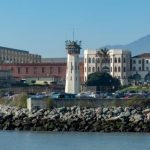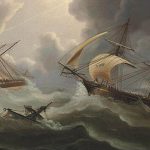 Mysteries
Mysteries  Mysteries
Mysteries  History
History 10 Surprising Stories About the Texas Rangers
 Humans
Humans 10 Philosophers Who Were Driven Mad by Their Own Theories
 Miscellaneous
Miscellaneous 10 Video-Game-Worthy Weapons and Armors from History
 Weird Stuff
Weird Stuff 10 Psychics Who Accurately Predicted Wartime Events
 The Arts
The Arts 10 Pieces of Art Inspired by a Broken Heart
 Health
Health 10 Science Fiction-Sounding New Medical Treatments
 History
History 10 Surprising Facts About the Father of Submarine Warfare
 Space
Space Ten Astonishing New Insights into Alien Worlds
 Weird Stuff
Weird Stuff 10 Bizarre Summer Solstice Rituals Still Practiced Today
 Mysteries
Mysteries Top 10 Haunting Facts About the Ghost Ship MV Alta
 History
History 10 Surprising Stories About the Texas Rangers
 Humans
Humans 10 Philosophers Who Were Driven Mad by Their Own Theories
Who's Behind Listverse?

Jamie Frater
Head Editor
Jamie founded Listverse due to an insatiable desire to share fascinating, obscure, and bizarre facts. He has been a guest speaker on numerous national radio and television stations and is a five time published author.
More About Us Miscellaneous
Miscellaneous 10 Video-Game-Worthy Weapons and Armors from History
 Weird Stuff
Weird Stuff 10 Psychics Who Accurately Predicted Wartime Events
 The Arts
The Arts 10 Pieces of Art Inspired by a Broken Heart
 Health
Health 10 Science Fiction-Sounding New Medical Treatments
 History
History 10 Surprising Facts About the Father of Submarine Warfare
 Space
Space Ten Astonishing New Insights into Alien Worlds
 Weird Stuff
Weird Stuff 10 Bizarre Summer Solstice Rituals Still Practiced Today
Ten Strange but True Geography Facts
Depending on your personal proclivities, geography was either the best or worst subject for you in school. It seems like there are very few in-betweens with that. Kids growing up either love studying geography and have a feel for where everything fits on a map, or they hate it and have horrible memories of the subject throughout their school years.
Even now, technology has made geography much the same. With GPS navigation in cars and on smartphones, you never have to have an innate understanding of where everything is in your city and what orientation you currently have. Just put an address into the GPS, and you’re off!
But the truth is that having at least a basic knowledge of geography and a simple feel for your surroundings can really help you. And for our purposes here, it can really help you learn random facts that you can then hold over your friends’ heads when it comes to future quiz hangouts! In this list, we’ll take a look at ten random, strange, and surprisingly true geography facts from around the globe. This isn’t “what’s the capital of Vermont” level stuff, folks. It’s a lot more fun than that! (The answer to that question is “Montpelier,” by the way. A true geography buff would know that!)
Related: Top 10 Places That Prove Our World Can Be Weird as Hell
10 Straddling Continents
The city of Istanbul, Turkey is the only city in the world that is located on two continents. Think about that fact for a minute. See, Istanbul is centered around a waterway called the Bosphorus Strait. That is a natural strait that connects the Black Sea to its north to the Sea of Marmara to its south.
While those two sea names probably don’t mean much to you unless you’re from Turkey or you’ve been there a lot, the Bosphorus itself actually holds important meaning. To the west of the Bosphorus is Europe, and to the east of the Bosphorus is Asia. Right there! All around you! So, you can be in the center of Istanbul and stuck right in between two continents!
In fact, that’s one of the coolest and most in-demand tourist destinations in Istanbul. Visitors from all over the world come to Turkey and make the trek to its largest city just to go to the Bosphorus Strait. As you get in a boat and start riding across the water there, you can turn your head one direction, see the western half of Istanbul, and recognize that you are looking at Europe. Then, you turn your head the other direction, see the city’s eastern half, and know that you are looking at Asia.
It’s not often you get a continental boundary like that in such stark and certain terms. But you do in Istanbul, and that alone makes it one of the most unique countries on earth![1]
9 What’s in a Name?
The world is a very large place, with an unimaginable number of cities, towns, villages, and other locales places that have been named in whatever local language is most popular. So we could do “strange name theater” literally all day. We won’t subject you to that! But there are a few very strange city names that deserve special focus.
Take the city of Batman in Turkey, for example. It’s no small town, either, with about half a million people living there. And it matches up so perfectly with the city of Gotham, Wisconsin. While the census-designated place of Gotham is much smaller than Batman’s by population, we do wonder if there’s a Bruce Wayne in town. Moving on…
The beautiful nation of Norway has a village in it named Hell. It sits on the water a few hundred miles north of Oslo, and knowing how wonderful Norway is, we’re pretty sure it’s not actually anything like Hell might be. Just very cold in the winter; in fact, hell freezes over! The state of Michigan also has a village named Hell, too. As of the last population count, 72 brave souls live in that tiny Livingston County hamlet. No word on whether one of them has reddish skin, fiery eyes, horns, and a tail.
But the all-time best combo in the strange geography name game has to go to “Boring,” “Dull,” and “Bland.” In the U.S. state of Oregon, there is a tiny town named Boring. It is home to about seven thousand people and sits in the far northwestern corner of the state. It was named after a former Civil War soldier who moved west and settled there with his family in the 19th century.
Well, somebody in Boring has a great sense of humor because, in recent years, it has been named a sister city to the village of Dull, Scotland, as well as the tiny town of Bland, Australia. The world loves that uninspiring combination so much that observers have taken to calling the Boring-Dull-Bland sister city grouping the “Trinity of Tedium.” Who said geography wasn’t fun?![2]
8 Deserted Deserts
The largest desert in the world is… drumroll, please… Antarctica! Yep. You probably thought we were going to tell you it was the Sahara Desert, the Gobi Desert, or something, didn’t you? Well, it’s not. Antarctica is both the largest and the coldest desert on Earth. Both of the planet’s poles are considered deserts, with the Arctic way up north being a barren land mostly devoid of life, too.
But Antarctica takes the cake as the world’s biggest desert. It covers about 5.5 million square miles (14.2 million square kilometers). That is a heck of a lot bigger than the Sahara Desert, which sits at roughly 3.5 million square miles (9 million square kilometers) in size. And the temperature in Antarctica gets brutally, unfathomably cold. The ice flats there have previously reached temperatures as low as -128°F (-88.9°C). Not so fun!
That said, Antarctica isn’t actually the driest place on earth, despite being the world’s largest desert. There is snowfall there at times, and that gives it some measurable precipitation. No, the driest place on Earth is a different desert, and one you may never have heard of: the Atacama Desert in the South American nation of Chile.
The Atacama, located in the Arica area of northern Chile, gets only about 0.03 inches (0.076 cm) of average annual rainfall. That is quite literally almost nothing! The area is so dry that NASA scientists have spent lots of time there studying the ecosystem in a bid to possibly learn more about life on other mostly barren planets in our solar system, like Mars. That says it all, doesn’t it?[3]
7 Canada’s Endless Coasts
Canada has—by far—the longest coastline of any country in the world. Canada is a massive country by overall area in general, coming in second only to Russia in terms of square mileage (or square kilometers, as it were, in the Canadian measurement system). So it makes sense that Canada has a ton of coastline. And because Canada is made up of so many islands, both large and small, in its far northern territories, that amount of coastline rises nearly exponentially while counting all those shores.
The actual numbers are staggering. Canada has 151,000 miles (243,042 kilometers) of coastline. And the next closest countries on the list aren’t even in Canada’s league! That’d be Indonesia (33,554 miles or 54,000 kilometers of coastline), Russia (nearly 23,612 miles or 38,000 kilometers), the United States (just under 12,430 miles or 20,000 kilometers), and China (almost 9,325 miles or 15,000 kilometers). Canada wins!
Canada wins in another way, too: the most lakes in the world. As if saltwater and access to oceans and seas weren’t enough for the Canadians, they also have more freshwater within their nation’s boundaries than any other country on Earth.
In total, Canada has 879,800 lakes all throughout its land. Not only is that the most lakes on earth, it’s actually more lakes than all other countries in the world COMBINED! When you account for the entire globe, Canada holds more than 60% of the world’s 1.4 million lakes. Russia is second on the lake list—if you’re curious—but they are nowhere close to Canada.[4]
6 Ride the Dutch Way
The Western European nation of the Netherlands has more bicycles than residents. That sounds like a particularly strange fact, and possibly a made-up one, but it’s not! It is 100% true. According to the United Nations and other census takers of various levels, at last count, the Netherlands had about 18 million residents and a whopping 22 million bicycles!
So that means there’s a bike for everybody in the country and another four million more cycles if, ya know, a ton of tourists showed up at one time or something. And that’s not including all the rideshare bicycle apps that have swept across big cities in recent years, either. So the bike number could technically be even higher than that!
It’s certainly amusing to think of the Netherlands as having more bikes than people, but the purpose behind it is pretty significant. Amsterdam and other cities in the small country have focused hard on sustainable living policies and creating walkable (and bikeable) communities. In turn, it’s simply easier to bike to a lot of places around the Netherlands’ large urban centers than it is to take a car. And people do just that! Call it green living or whatever you want to call it, but biking culture seems to really work in the Netherlands. Nothing wrong with getting a little exercise and some fresh air, right?[5]
5 No Volcano? No Problem!
Here’s a fun fact for you. Australia is the only continent on Earth without an active volcano. And yes, before you ask, we’ll just tell you: Antarctica does indeed have an active volcano. It has several, in fact! One is called Mount Sidley, and another is called Mount Erebus, and they are the southernmost active volcanoes on Earth.
But back to Australia. The land Down Under has no active volcanoes anywhere on the Australian mainland and no real geological risk to ever have an active volcano throughout, well, all the rest of time.
That’s because Australia sits right smack-dab in the middle of what is known as the Indo-Australian Tectonic Plate. Because of its central location on that very large shelf of rock, Australia doesn’t experience any adverse effects from the earth moving and shifting around underneath it. The continent just kind of rides out all the shifts and slips and comes away mostly unscathed from any real danger.
It’s kind of ironic because the Pacific Ring of Fire goes right by Australia to its north and east. Along the edges of that Indo-Australian Tectonic Plate, Australia’s nearby neighbors like Papua New Guinea and Indonesia deal with constant volcano trouble. But Australia is left unscathed![6]
4 Staying on the Surface
The Dead Sea is so salty that people can float entirely on top of the surface of the water without needing to tread water, kick their legs, or use any personal flotation device. The Dead Sea isn’t actually a sea at all. It’s a lake, despite its name.
And it’s what is known as a “hypersaline” lake, which means it is a landlocked body of water that has an absurdly high sodium chloride concentration to go along with a bunch of other mineral salts. In turn, it is nearly ten times saltier than the ocean and one of the saltiest bodies of water in the world. It is also the lowest point on Earth—if you’re into altitude facts.
But because of all its unique salinity traits, it allows people to “swim” in it by pretty much staying right above the surface of the water. Now, it’s not salty enough to allow you to stand on top of the water or anything like that. But you definitely won’t sink down in the lake even if you aren’t such a good swimmer!
Take a book or a magazine, lay yourself out in the water, and float away! Just don’t drink it or anything. The salinity content won’t harm your skin if you hang out in it for a couple hours, but you definitely shouldn’t be ingesting Dead Sea water if you can help it.[7]
3 Russia Runs on and on…
Russia is, by far, the largest country in the world. That alone probably doesn’t seem like much of a fact. After all, some country has to be the world’s biggest, right? So what’s the big (pun intended) deal if Russia is the one to take the title by sheer land mass and area? And you’d be right on that level.
However, when you start to consider just how big Russia really is, the numbers are kind of staggering. First, to be technical, Russia covers about 6.6 million square miles or over 17,125,000 square kilometers in land area. The United States, by comparison, only covers about 3.8 million square miles (9.8 million square kilometers)of land. And by all measures, the U.S. is a massive country. So Russia is truly huge!
Beyond the raw numbers, Russia is so large that it covers more than one-eighth of the entirety of the world’s land area. All in just one country! And because it is so large, and so spread out, Russia has the most time zones of any country on Earth, too. The nation requires eleven time zones to account for all of its extended lands out into Siberia and the Far (far, far) East.
When it’s dawn in Moscow, it’s dusk in the Far East. Imagine living in one country where its extremes are on entirely different ends of the day! And because it covers so much ground, it also has a lot of land borders with a lot of other nations. Russia has the most geographical connections of any country on Earth, too, sharing a common border with a whopping sixteen other nations.[8]
2 No Water for You!
A country is “doubly landlocked” if it is landlocked on its own, for one, but also if the countries that border it are themselves landlocked. So, not only does a doubly landlocked nation have no access to deep water ports or ocean channels for the purposes of trade for themselves, but they also don’t have easy access to the ports of other nations through which they can drive trade.
That’s not exactly an ideal situation, especially if a country is or hopes to be a notable producer of manufactured goods, minerals, or pretty much anything else they would do well to get out on ships and send off into the greater world to bring back economic value.
Fortunately for most of the world, but unfortunately for these nations in question, there are only two doubly landlocked countries on Earth: Liechtenstein in Western Europe and Uzbekistan in Central Asia. Liechtenstein has the poor fortune of being surrounded by both Austria and Switzerland, which are themselves entirely landlocked.
Liechtenstein is geographically very tiny and doesn’t manufacture many goods compared to other nations, anyway. So perhaps it’s less of a surprise and no real shock that they are so land-ridden. Uzbekistan, on the other hand, has it a little bit worse. Not only is it a larger country, but it has many more neighbors: Afghanistan, Kazakhstan, Kyrgyzstan, Tajikistan, and Turkmenistan. And none of them have ocean access, either![9]
1 Way out West
The city of Reno, Nevada, is situated further west than the city of Los Angeles, California. We’ll repeat that one for you just in case you read it too quickly and glossed over the fact there—Reno is further west than Los Angeles. Don’t believe us? Just look at a map!
Yes, Nevada just so happens to be California’s eastern neighbor. And yes, Los Angeles sits right on the coastline of the Pacific Ocean—you know, the westernmost boundary of the contiguous United States. But Reno is actually further west than LA, and it’s not even close!
Speaking geographically, Reno sits at 119°49′ West. In turn, Los Angeles sits at just 118°14′ West. So the so-called “Biggest Little City in the World” is further west than Tinseltown despite sitting one full state inland from the Pacific Ocean. That’s a mind-warper, isn’t it?
Of course, things become a bit clearer when you consider how the southern California coastline bends southeast as the state gives way to Mexico. But still, it’s pretty wild to think about how Reno gets (slightly) later sunsets than LA![10]








